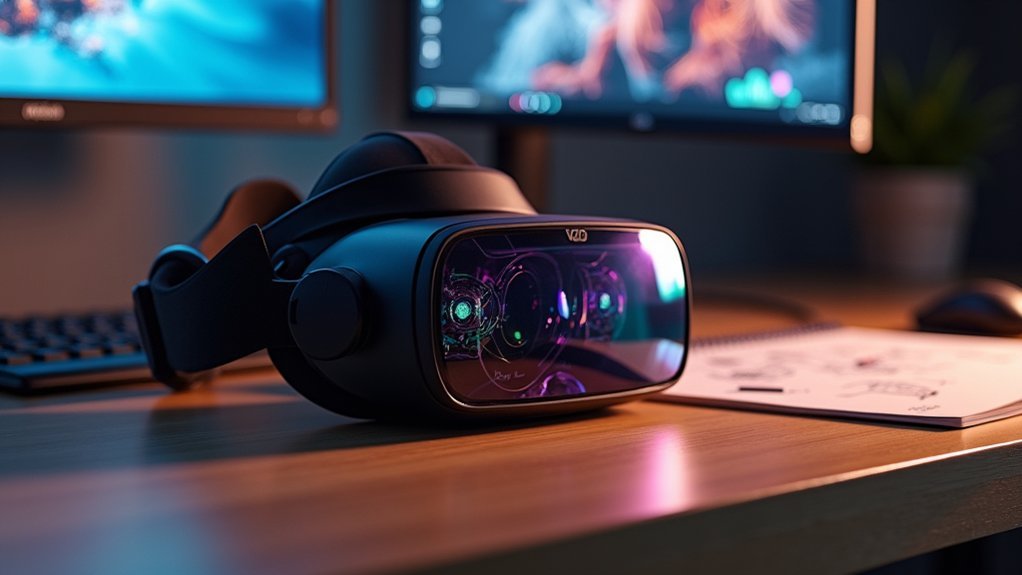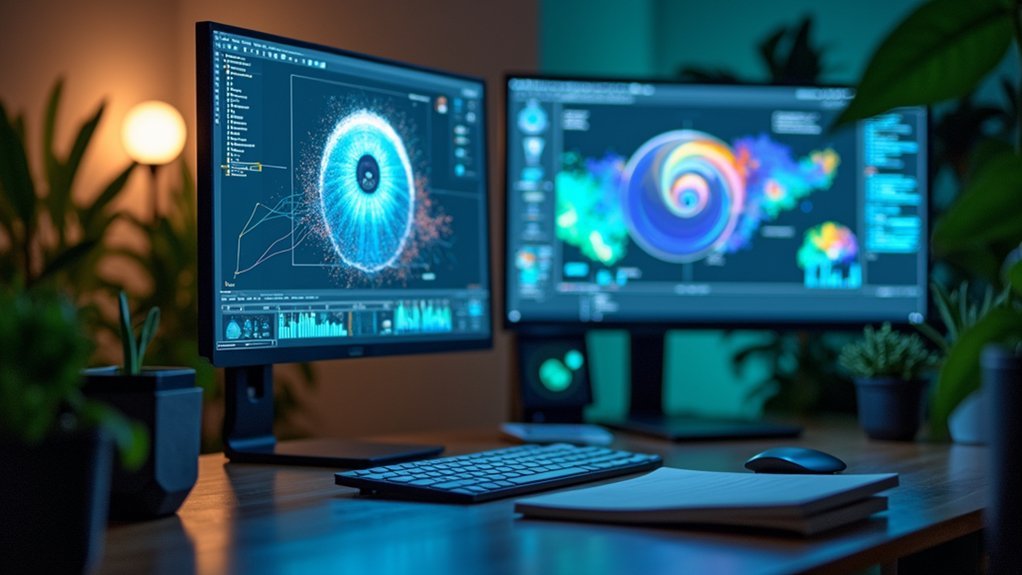You’ll find the right eye tracking SDK among these seven solutions that cater specifically to different immersive development needs. EyeLink SDK delivers laboratory-grade precision for academic research, while Tobii Eye Tracker 5 SDK offers consumer-friendly gaming integration. Varjo Aero provides professional VR development, Pupil Labs Core enables open-source customization, and Eyeware Beam transforms webcams into tracking systems. Smart Eye Pro specializes in automotive applications, and Apple ARKit handles native iOS AR experiences. Each platform brings unique strengths to enhance your immersive projects.
EyeLink SDK by SR Research – Laboratory-Grade Precision for Academic Research
When precision matters most in your research, the EyeLink SDK by SR Research delivers laboratory-grade accuracy that’s earned the trust of cognitive psychologists, neuroscientists, and vision researchers worldwide.
With over 14.7K academic publications citing EyeLink, you’re working with one of the most validated eye tracker systems available.
You’ll appreciate the flexibility of both portable and head-mounted configurations, allowing you to adapt your experimental setup to any research environment.
The SDK’s high accuracy and low latency capabilities guarantee you’ll capture detailed gaze patterns without missing critical data points.
Whether you’re conducting basic cognitive research or complex neuroscience experiments, EyeLink’s robust data collection features support diverse experimental designs, helping you achieve the depth and quality your research demands.
Tobii Eye Tracker 5 SDK – Consumer-Friendly Integration for Gaming Applications
Gaming transforms when you integrate the Tobii Eye Tracker 5 SDK, bringing gaze-based interactions that elevate player immersion beyond traditional input methods. This eye tracking technology supports screens from 15-30 inches with precise tracking in varying light conditions.
| Feature | Specification |
|---|---|
| Operating Distance | 45-95 cm |
| Field of View | 40 x 40 degrees |
| System Requirements | Windows 10, 6th gen Intel Core/AMD equivalent |
You’ll appreciate the tool-free Flex Mount that adheres to various monitor types, simplifying setup considerably. The SDK’s broad accessibility stems from its consumer-friendly design and minimum system specifications. With high-precision tracking capabilities, you can create engaging experiences that respond naturally to where players look, revolutionizing gameplay mechanics.
Varjo Aero Eye Tracking SDK – Professional-Grade VR Headset Development

When you’re developing professional VR applications that demand enterprise-level precision, Varjo’s Aero Eye Tracking SDK delivers the advanced foveated rendering technology that’ll optimize your graphics performance while maintaining stunning visual quality.
You’ll get the same NASA-grade tracking precision that aerospace giants like Boeing trust for their critical training simulations and high-stakes environments.
The SDK’s mixed reality integration capabilities let you seamlessly blend virtual and real-world elements, creating immersive experiences that push beyond traditional VR boundaries.
Advanced Foveated Rendering
As computational demands in VR continue to escalate, the Varjo Aero Eye Tracking SDK revolutionizes how developers approach rendering enhancement through advanced foveated rendering technology.
You’ll dramatically reduce GPU workload by rendering full resolution only where users actively look, while peripheral areas receive lower-quality rendering that’s imperceptible to human vision.
This intelligent resource allocation lets you achieve photorealistic visuals without compromising performance. The SDK’s precise gaze tracking enables real-time adjustments, ensuring smooth frame rates even in complex simulations.
You’re working with the same technology trusted by NASA and Boeing for mission-critical training applications.
Eye Trackers integrated with Varjo’s hardware deliver sub-millisecond latency, making foveated rendering seamless and undetectable.
You’ll maximize visual fidelity while maintaining peak performance across demanding professional applications.
NASA-Grade Precision Tracking
Precision becomes paramount when developing applications for aerospace training and critical simulations, where the Varjo Aero Eye Tracking SDK delivers NASA-grade accuracy that’s proven in real-world mission scenarios. You’ll access the same tracking data quality trusted by industry leaders like NASA and Boeing for their professional applications.
| Feature | Specification | Application |
|---|---|---|
| Accuracy | Sub-degree precision | Mission-critical training |
| Sampling Rate | High-frequency capture | Real-time simulations |
| Calibration | Professional-grade | Research environments |
Your development projects benefit from enterprise-level eye tracking that maintains consistent performance under demanding conditions. The SDK’s robust tracking data enables sophisticated gaze analysis for training effectiveness assessment, making it ideal for developing applications where precision directly impacts safety and operational success in professional environments.
Mixed Reality Integration
Since mixed reality applications demand seamless integration between virtual and physical environments, the Varjo Aero Eye Tracking SDK enables you to build professional-grade experiences that respond naturally to user gaze patterns.
You’ll leverage advanced gaze tracking capabilities to create realistic interactions and intuitive user interfaces that greatly boost user engagement and immersion.
The SDK’s foveated rendering technology optimizes your computational resources by reducing rendering workload in peripheral vision areas, enhancing overall performance in demanding applications.
You can seamlessly integrate these features with your existing development tools, making implementation straightforward and efficient.
With organizations like NASA and Boeing trusting this technology for high-stakes professional environments, you’re working with proven, industry-leading capabilities that deliver exceptional mixed reality experiences.
Pupil Labs Core SDK – Open-Source Modular Eye Tracking Solutions
Pupil Labs Core SDK revolutionizes eye tracking development by providing an open-source, modular platform that puts complete customization control in your hands. You can integrate both hardware and software components seamlessly, making it perfect for research projects, user experience testing, and interactive applications. The SDK works with Pupil Labs’ developer-focused eye tracking glasses, designed specifically for creating innovative virtual and augmented reality interactions.
| Feature | Benefit |
|---|---|
| Open-source platform | Complete customization freedom |
| Modular architecture | Flexible component integration |
| Affordable pricing | Accessible to broader user base |
| Extensive documentation | Streamlined development process |
You’ll appreciate the emphasis on accessibility and affordability, which democratizes eye tracking technology for developers across different budgets. The community-driven approach provides thorough documentation and collaborative support, making experimentation straightforward.
Eyeware Beam API – AI-Powered Webcam Eye Tracking Technology
While traditional eye tracking requires specialized hardware, Eyeware Beam API breaks this barrier by transforming any standard webcam into a sophisticated head and eye tracking system.
You’ll gain access to real-time tracking data that seamlessly integrates into your gaming platforms and biometric applications without expensive equipment investments.
This AI-powered solution makes eye tracking technology accessible across multiple platforms, enabling you to develop interactive models that boost user engagement.
You can create innovative applications spanning gaming, education, and accessibility sectors while maintaining cost-effectiveness.
The API’s cross-platform compatibility guarantees you’re not limited by specific operating systems or hardware configurations.
Whether you’re building consumer applications or commercial solutions, Eyeware Beam’s affordable approach democratizes advanced eye tracking capabilities for developers seeking powerful, accessible tracking solutions.
Smart Eye Pro SDK – Automotive and Industrial Application Development
As automotive technology advances toward greater automation, Smart Eye Pro SDK delivers specialized eye tracking capabilities that transform how you develop driver monitoring systems and industrial applications.
You’ll harness advanced AI-powered gaze tracking technology that analyzes driver attention and engagement levels in real-time, creating safer semi-autonomous vehicle experiences.
The SDK’s versatility extends beyond automotive development. You can integrate it seamlessly into flight simulation scenarios to study pilot behavior and decision-making processes.
In industrial settings, you’ll optimize human-machine interactions and boost operational efficiency through precise eye movement analysis.
Smart Eye Pro SDK’s compatibility with various automotive systems guarantees smooth integration into your existing development workflow.
Whether you’re conducting human factors research or developing next-generation driver assistance systems, this specialized toolkit provides the precision and reliability your automotive and industrial projects demand.
Apple ARKIT Eye Tracking – Native Ios Integration for Mobile AR Experiences
Revolutionary capabilities await you with Apple ARKit Eye Tracking, which brings native iOS integration that transforms how you’ll develop mobile AR experiences.
You’ll harness advanced functionalities including 2D image detection, real-time facial tracking, and motion tracking when building applications for A9 processors or higher. The SDK enables stable, fast motion tracking that lets you place virtual objects realistically in real-world environments.
You can leverage eye tracking as an engagement metric, creating more intuitive user interactions through gaze-based controls.
ARKit’s broad iOS device compatibility guarantees you’ll reach extensive audiences while developing immersive AR applications. The seamless integration eliminates complex setup procedures, allowing you to focus on crafting compelling experiences that blend digital content with physical environments through sophisticated eye tracking technology.
Frequently Asked Questions
What Is the Most Accurate Eye Tracking System?
You’ll find EyeLink from SR Research is the most accurate eye tracking system available. It’s widely recognized for high precision in cognitive psychology and neuroscience research, with over 14,700 academic publications validating its accuracy.
What Eye Tracking Software Do Streamers Use?
You’ll typically find streamers using Tobii Eye Tracker 5 for gaming content, Eyeware Beam’s smartphone solution for budget-friendly setups, or Gazepoint devices when they’re analyzing viewer engagement patterns during broadcasts.
What Is the Best Computer Eye Tracker?
You’ll find Tobii Eye Tracker 5 offers the best balance for general computer use, supporting 15-30 inch screens with excellent precision. EyeLink provides superior accuracy if you’re doing serious research work.
What Eye Tracking Software Is Used in Star Citizen?
You’ll find Star Citizen uses Tobii Eye Tracker technology, specifically supporting the Tobii Eye Tracker 5. This integration lets you control navigation and interact with UI elements using your gaze for enhanced immersion.
In Summary
You’ve now got seven powerful eye tracking SDKs to choose from for your immersive development projects. Whether you’re building academic research tools, gaming applications, or professional VR experiences, there’s an SDK that’ll match your specific needs and budget. Consider your platform requirements, precision needs, and development timeline when making your choice. Start experimenting with these tools and you’ll reveal new possibilities for creating truly intuitive, gaze-driven user experiences.





Leave a Reply